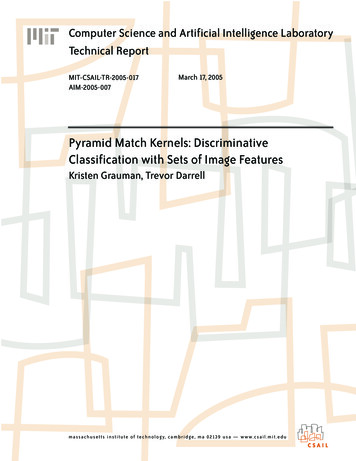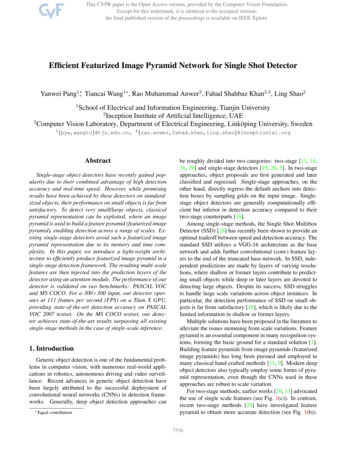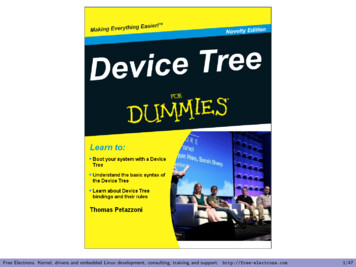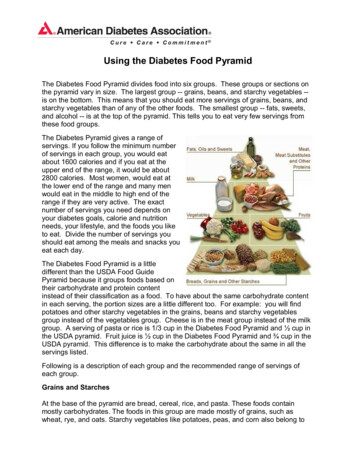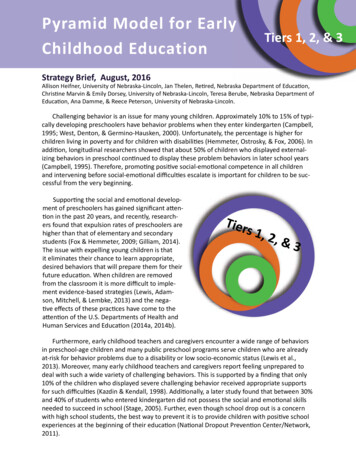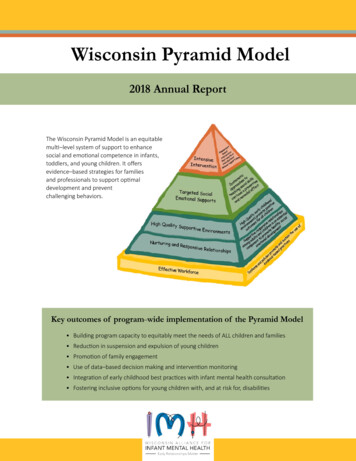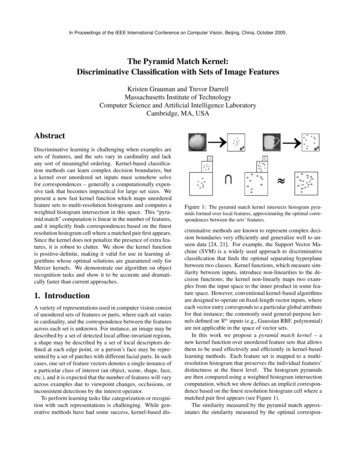
Transcription
In Proceedings of the IEEE International Conference on Computer Vision, Beijing, China, October 2005.The Pyramid Match Kernel:Discriminative Classification with Sets of Image FeaturesKristen Grauman and Trevor DarrellMassachusetts Institute of TechnologyComputer Science and Artificial Intelligence LaboratoryCambridge, MA, USAAbstractDiscriminative learning is challenging when examples aresets of features, and the sets vary in cardinality and lackany sort of meaningful ordering. Kernel-based classification methods can learn complex decision boundaries, buta kernel over unordered set inputs must somehow solvefor correspondences – generally a computationally expensive task that becomes impractical for large set sizes. Wepresent a new fast kernel function which maps unorderedfeature sets to multi-resolution histograms and computes aweighted histogram intersection in this space. This “pyramid match” computation is linear in the number of features,and it implicitly finds correspondences based on the finestresolution histogram cell where a matched pair first appears.Since the kernel does not penalize the presence of extra features, it is robust to clutter. We show the kernel functionis positive-definite, making it valid for use in learning algorithms whose optimal solutions are guaranteed only forMercer kernels. We demonstrate our algorithm on objectrecognition tasks and show it to be accurate and dramatically faster than current approaches.1. IntroductionA variety of representations used in computer vision consistof unordered sets of features or parts, where each set variesin cardinality, and the correspondence between the featuresacross each set is unknown. For instance, an image may bedescribed by a set of detected local affine-invariant regions,a shape may be described by a set of local descriptors defined at each edge point, or a person’s face may be represented by a set of patches with different facial parts. In suchcases, one set of feature vectors denotes a single instance ofa particular class of interest (an object, scene, shape, face,etc.), and it is expected that the number of features will varyacross examples due to viewpoint changes, occlusions, orinconsistent detections by the interest operator.To perform learning tasks like categorization or recognition with such representations is challenging. While generative methods have had some success, kernel-based dis-Figure 1: The pyramid match kernel intersects histogram pyramids formed over local features, approximating the optimal correspondences between the sets’ features.criminative methods are known to represent complex decision boundaries very efficiently and generalize well to unseen data [24, 21]. For example, the Support Vector Machine (SVM) is a widely used approach to discriminativeclassification that finds the optimal separating hyperplanebetween two classes. Kernel functions, which measure similarity between inputs, introduce non-linearities to the decision functions; the kernel non-linearly maps two examples from the input space to the inner product in some feature space. However, conventional kernel-based algorithmsare designed to operate on fixed-length vector inputs, whereeach vector entry corresponds to a particular global attributefor that instance; the commonly used general-purpose kernels defined on n inputs (e.g., Gaussian RBF, polynomial)are not applicable in the space of vector sets.In this work we propose a pyramid match kernel – anew kernel function over unordered feature sets that allowsthem to be used effectively and efficiently in kernel-basedlearning methods. Each feature set is mapped to a multiresolution histogram that preserves the individual features’distinctness at the finest level. The histogram pyramidsare then compared using a weighted histogram intersectioncomputation, which we show defines an implicit correspondence based on the finest resolution histogram cell where amatched pair first appears (see Figure 1).The similarity measured by the pyramid match approximates the similarity measured by the optimal correspon-
dences between feature sets of unequal cardinality (i.e., thepartial matching that optimally maps points in the lowercardinality set to some subset of the points in the larger set,such that the summed similarities between matched pointsis maximal). Our kernel is extremely efficient and can becomputed in time that is linear in the sets’ cardinality. Weshow that our kernel function is positive-definite, meaningthat it is appropriate to use with learning methods that guarantee convergence to a unique optimum only for positivedefinite kernels (e.g., SVMs).Because it does not penalize the presence of superfluous data points, the proposed kernel is robust to clutter. Aswe will show, this translates into the ability to handle unsegmented images with varying backgrounds or occlusions.The kernel also respects the co-occurrence relations inherent in the input sets: rather than matching features in a setindividually, ignoring potential dependencies conveyed byfeatures within one set, our similarity measure captures thefeatures’ joint statistics.Other approaches to this problem have recently been proposed [25, 14, 3, 12, 27, 16, 20], but unfortunately each ofthese techniques suffers from some number of the following drawbacks: computational complexities that make largefeature set sizes infeasible; limitations to parametric distributions which may not adequately describe the data; kernels that are not positive-definite (do not guarantee uniquesolutions for an SVM); limitations to sets of equal size; andfailure to account for dependencies within feature sets.Our method addresses all of these issues, resulting ina kernel appropriate for comparing unordered, variablelength feature sets within any existing kernel-based learning paradigm. We demonstrate our algorithm with objectrecognition tasks and show that its accuracy is comparable to current approaches, while requiring significantly lesscomputation time.2. Related WorkIn this section, we review related work on discriminativeclassification with sets of features, using kernels and SVMsfor recognition, and multi-resolution image representations.Object recognition is a challenging problem that requires strong generalization ability from a classifier in order to cope with the broad variety in illumination, viewpoint, occlusions, clutter, intra-class appearances, and deformations that images of the same object or object classwill exhibit. While researchers have shown promising results applying SVMs to object recognition, they have generally used global image features – ordered features of equallength measured from the image as a whole, such as color orgrayscale histograms or vectors of raw pixel data [5, 18, 17].Such global representations are known to be sensitive toreal-world imaging conditions, such as occlusions, poseMethodMatch [25]Exponent [14]Greedy [3]Princ. ang. [27]Bhattach.’s [12]KL-div. [16]PyramidComplexityO(dm2 )O(dm2 )O(dm2 )O(dm3 )O(dm3 )O(dm2 )O(dm log D)CPxxxxxxMxxxUxxxxxxxxxxTable 1: Comparing kernel approaches to matching unorderedsets. Columns show each method’s computational cost andwhether its kernel captures co-occurrences (C), is positive-definite(P), does not assume a parametric model (M), and can handle setsof unequal cardinality (U). d is vector dimension, m is maximumset cardinality, and D is diameter of vector space. “Pyramid”refers to the proposed kernel.changes, or image noise.Recent work has shown that local features invariant tocommon image transformations (e.g., SIFT [13]) are a powerful representation for recognition, because the featurescan be reliably detected and matched across instances ofthe same object or scene under different viewpoints, poses,or lighting conditions. Most approaches, however, performrecognition with local feature representations using nearestneighbor (e.g., [1, 8, 22, 2]) or voting-based classifiers followed by an alignment step (e.g., [13, 15]); both may beimpractical for large training sets, since their classificationtimes increase with the number of training examples. AnSVM, on the other hand, identifies a sparse subset of thetraining examples (the support vectors) to delineate a decision boundary.Kernel-based learning algorithms, which include SVMs,kernel PCA, or Gaussian Processes, have become wellestablished tools that are useful in a variety of contexts,including discriminative classification, regression, densityestimation, and clustering [21]. More recently, attentionhas been focused on developing specialized kernels that canmore fully leverage these tools for situations where the datacannot be naturally represented by a Euclidean vector space,such as graphs, strings, or trees.Several researchers have designed similarity measuresthat operate on sets of unordered features. See Table 1for a concise comparison of the approaches. The authorsof [25] propose a kernel that averages over the similaritiesof the best matching feature found for each feature memberwithin the other set. The use of the “max” operator in thiskernel makes it non-Mercer (i.e., not positive-definite – seeSection 3), and thus it lacks convergence guarantees whenused in an SVM. A similar kernel is given in [14], whichalso considers all possible feature matchings but raises thesimilarity between each pair of features to a given power.Both [25] and [14] have a computational complexity thatis quadratic in the number of features. Furthermore, both
match each feature in a set independently, ignoring potentially useful co-occurrence information. In contrast, ourkernel captures the joint statistics of co-occurring featuresby matching them concurrently as a set.The method given in [3] is based on finding a suboptimal matching between two sets using a greedy heuristic; although this results in a non-Mercer kernel, the authors provide a means of tuning the kernel hyperparameterso as to limit the probability that a given kernel matrix isnot positive-definite. The authors of [27] measure similarity in terms of the principal angle between the two linearsubspaces spanned by two sets’ vector elements. This kernel is only positive-definite for sets of equal cardinality, andits complexity is cubic in the number of features. In [20],an algebraic kernel is used to combine similarities given byvector-based kernels, with the weighting chosen to reflectwhether the features are in alignment (ordered). When setcardinalities vary, inputs are padded with zeros so as to formequally-sized matrices.In [12], a Gaussian is fit to each set of vectors, andthen the kernel value between two sets is the Bhattacharyyaaffinity between their Gaussian distributions. As noted bythe authors, the method is constrained to using a Gaussianmodel in order to have a closed form solution. In practice,the method in [12] is also limited to sets with small cardinality, because its complexity is cubic in the number offeatures. Similarly, the authors of [16] fit a Gaussian to afeature set, and then compare sets using KL-divergence asa distance measure. Unlike the kernels of [12] and [16],which are based on parametric models that assume inputswill fit a certain form, our method is model-free and maintains the distinct data points in the representation.An alternative approach when dealing with unordered setdata is to designate prototypical examples from each class,and then represent examples in terms of their distances toeach prototype; standard algorithms that handle vectors ina Euclidean space are then applicable. The authors of [28]build such a classifier for handwritten digits, and use theshape context distance of [1] as the measure of similarity. The issues faced by such a prototype-based methodare determining which examples should serve as prototypes,choosing how many there should be, and updating the prototypes properly when new types of data are encountered.Our feature representation is based on a multi-resolutionhistogram, or “pyramid”, which is computed by binningdata points into discrete regions of increasingly larger size.Single-level histograms have been used in various visualrecognition systems, one of the first being that of [23],where the intersection of global color histograms was usedto compare images. Pyramids have been shown to be auseful representation in a wide variety of image processingtasks – see [9] for a summary.In [10], multi-resolution histograms are compared withL1 distance to approximate a least-cost matching of equalmass global color histograms for nearest neighbor image retrievals. This work inspired our use of a similar representation for point sets. However, unlike [10], our method buildsa discriminative classifier, and it compares histograms witha weighted intersection rather than L1 . Our method allowsinputs to have unequal cardinalities and thus enables partial matchings, which is important in practice for handlingclutter and unsegmented images.We believe ours is the first work to advocate for the useof a histogram pyramid as an explicit discriminative feature formed over sets, and the first to show its connectionto optimal partial matching when used with a hierarchicalweighted histogram intersection similarity measure.3. ApproachKernel-based learning algorithms [21, 24] are founded onthe idea of embedding data into a Euclidean space, and thenseeking linear relations among the embedded data. For example, an SVM finds the optimal separating hyperplane between two classes in an embedded space (also referred toas the feature space). A kernel function K : X X serves to map pairs of data points in an input space X totheir inner product in the embedding space F , thereby evaluating the similarities between all points and determiningtheir relative positions. Linear relations are sought in theembedded space, but a decision boundary may still be nonlinear in the input space, depending on the choice of a feature mapping function Φ : X F .The main contribution of this work is a new kernel function based on implicit correspondences that enables discriminative classification for unordered, variable-length setsof vectors. The kernel is provably positive-definite. Themain advantages of our algorithm are its efficiency, its useof implicit correspondences that respect the joint statisticsof co-occurring features, and its resistance to clutter or “superfluous” data points.The basic idea of our method is to map sets of featuresto multi-resolution histograms, and then compare the histograms with a weighted histogram intersection measure inorder to approximate the similarity of the best partial matching between the feature sets. We call the proposed kernel a“pyramid match kernel” because input sets are converted tomulti-resolution histograms.3.1. The Pyramid Match KernelWe consider an input space X of sets of d-dimensional feature vectors that are bounded by a sphere of diameter D andwhose minimum inter-vector distance is 2d :1 X x x [f11 , . . . , fd1 ], . . . , [f1mx , . . . , fdmx ] , (1)1 Thismay be enforced by scaling the data appropriately.
where mx varies across instances in X.The feature extraction function Ψ is defined as:Ψ(x) [H 1 (x), H0 (x), . . . , HL (x)],yH (y)0wi Ni ,(3)i 0where Ni signifies the number of newly matched pairs atlevel i. A new match is defined as a pair of features thatwere not in correspondence at any finer resolution level.The kernel implicitly finds correspondences betweenpoint sets, if we consider two points matched once they fallinto the same histogram bin (starting at the finest resolutionlevel where each point is guaranteed to be in its own bin).The matching is equivalent to a hierarchical process: vectors not found to correspond at a high resolution have theopportunity to be matched at lower resolutions. For example, in Figure 2, there are two points matched at the finestscale, two new matches at the medium scale, and one at thecoarsest scale. K ’s output value reflects the overall similarity of the matching: each newly matched pair at leveli contributes a value wi that is proportional to how similartwo points matching at that level must be, as determined bythe bin size. Note that the sum in Eqn. 3 starts with indexi 0, because the definition of Ψ insures that no pointsmatch at level i 1.To calculate Ni , the kernel makes use of a histogramintersection function I, which measures the “overlap” between two histograms’ bins:I (A, B) r min A(j) , B(j) ,0min(H (y), H (z))00I0 2words, Ψ(x) is a vector of concatenated histograms, whereeach subsequent component histogram has bins that doublein size (in all d dimensions) compared to the previous one.The bins in the finest-level histogram H 1 are small enoughthat each d-dimensional data point from sets in X falls intoits own bin, and then the bin size increases until all datapoints from sets in X fall into a single bin at level L.The pyramid match kernel K measures similarity between point sets based on implicit correspondences foundwithin this multi-resolution histogram space. The similaritybetween two input sets is defined as the weighted sum ofthe number of feature matchings found at each level of thepyramid formed by Ψ:L H (z)(2)where L log2 D , x X, Hi (x) is a histogram vectorformed over data x using d-dimensional bins of side length d 2i , and Hi (x) has a dimension ri 2iD d . In otherK (Ψ(y), Ψ(z)) z(4)j 1where A and B are histograms with r bins, and A(j) denotes the count of the j th bin of A.yzH (y)1H (z)1min(H1(y), H1(z))I1 4yzH2(y)H2(z)min(H2(y), H2(z))I2 5(a) Point sets(b) Histogram pyramids(c) IntersectionsFigure 2: A pyramid match determines a partial correspondenceby matching points once they fall into the same histogram bin. Inthis example, two 1-D feature sets are used to form two histogrampyramids. Each row corresponds to a pyramid level. H 1 is notpictured here because no matches are formed at the finest level. In(a), the set y is on the left side, and the set z is on the right. (Pointsare distributed along the vertical axis, and these same points arerepeated at each level.) Light dotted lines are bin boundaries, bolddashed lines indicate a pair matched at this level, and bold solidlines indicate a match already formed at a finer resolution level. In(b) multi-resolution histograms are shown, with bin counts alongthe horizontal axis. In (c) the intersection pyramid between thehistograms in (b) are shown. K uses this to measure how manynew matches occurred at each level. Ii refers to I(Hi (y), Hi (z)).Here, Ii 2, 4, 5 across levels, and therefore the number of newmatches found at each level are Ni 2, 2, 1. The sum over Ni ,weighted by wi 1, 12 , 14 , gives the pyramid match similarity.Histogram intersection effectively counts the number ofpoints in two sets which match at a given quantization level,i.e., fall into the same bin. To calculate the number of newlymatched pairs Ni induced at level i, it is sufficient to compute the difference between successive histogram levels’ intersections:Ni I (Hi (y), Hi (z)) I (Hi 1 (y), Hi 1 (z)) ,(5)where Hi refers to the ith component histogram generatedby Ψ in Eqn. 2. Note that the kernel is not searching explicitly for similar points – it never computes distances betweenthe vectors in each set. Instead, it simply uses the changein intersection values at each histogram level to count thematches as they occur.The number of new matches found at each level inthe pyramid is weighted according to the size of thathistogram’s bins: matches made within larger bins areweighted less than those found in smaller bins. Since thelargest diagonal of a d-dimensionalhypercube bin with sides of length 2i has length 2i d, the maximal distance
between any two points in one bin doubles at each increasingly coarser histogram in the pyramid. Thus, the numberof new matches induced at level i is weighted by 21i to reflect the (worst-case) similarity of points matched at thatlevel. Intuitively, this means that similarity between vectors(features in y and z)) at a finer resolution – where featuresare most distinct – is rewarded more heavily than similaritybetween vectors at a coarser level.From Eqns. 3, 4, and 5, we define the (un-normalized)pyramid match kernel function:L”X1“I (Hi (y), Hi (z)) I(Hi 1 (y), Hi 1 (z)) ,i2i 0(6)X, and Hi (x) is the ith histogram in Ψ(x).K̃ (Ψ(y), Ψ(z)) where y, z We normalize this value by the product of each input’s selfsimilarity to avoid favoring larger input sets, arriving at thefinal kernel value K (P, Q) 1C K̃ (P, Q), where C K̃ (P, P) K̃ (Q, Q).In order to alleviate quantization effects that may arisedue to the discrete histogram bins, we can combine thekernel values resulting from multiple (T ) pyramid matchesformed under different multi-resolution histograms withrandomly shifted bins. Each dimension of each of the Tpyramids is shifted by an amount chosen uniformly at random between 0 and D. This yields T feature mappingsΨ1 , . . . , ΨT that are applied as in Eqn. 2 to map an input sety to T multi-resolution histograms: [Ψ1 (y), . . . , ΨT (y)].For T inputs y and z, the combined kernel value is thenj 1 K (Ψj (y), Ψj (z)).3.2. Partial Match CorrespondencesOur kernel allows sets of unequal cardinalities, and therefore it enables partial matchings, where the points of thesmaller set are mapped to some subset of the points in thelarger set. Dissimilarity is only judged on the most similar part of the empirical distributions, and superfluous datapoints are ignored; the result is a robust similarity measurethat accommodates inputs expected to contain extraneousvector entries. This is a common situation when recognizing objects in images, due for instance to background variations, clutter, or changes in object pose that cause differentsubsets of features to be visible. Thus, the proposed kernelis equipped to handle unsegmented examples, as we willdemonstrate in Section 4.By construction, the pyramid match offers an approximation of the optimal correspondence-based matching between two feature sets, in which the overall similarity between corresponding points is maximized. When inputsets have equal cardinalities, histogram intersection canbe reduced to an L1 distance: I(H(y), H(z)) m 12 H(y) H(z) L1 if m y z [23]. Intersection over the pyramid with weights set to wi 21i thenstrictly approximates the optimal bipartite matching [10].With variable cardinalities no similar proof is available, butwe show empirically below that the intersection of multiresolution histograms approximates the best partial matching both in simulation and in practice.Since the pyramid match defines correspondences acrossentire sets simultaneously, it inherently accounts for dependencies between various features occurring in one set.In contrast, previous approaches have used each feature ina set to independently index into the second set; this ignores possibly useful information that is inherent in the cooccurrence of a set of distinctive features, and it fails todistinguish between instances where an object has varyingnumbers of similar features since multiple features may bematched to a single feature in the other set [25, 14].3.3. Satisfying Mercer’s ConditionOnly positive semi-definite kernels guarantee an optimalsolution to kernel-based algorithms based on convex optimization, including SVMs. According to Mercer’s theorem,a kernel K is positive semi-definite if and only ifK(xi , xj ) Φ(xi ), Φ(xj ) , xi , xj X,(7)where · denotes a scalar dot product. This insures thatthe kernel corresponds to an inner product in some featurespace, where kernel methods can search for linear relations[21].Histogram intersection on single resolution histogramsover multi-dimensional data is a positive-definite similarityfunction [17]. Using this construct and the closure properties of valid kernel functions, we can show that the pyramidmatch kernel is a Mercer kernel. The definition given inEqn. 6 is algebraically equivalent toK (Ψ(y), Ψ(z)) L 1X 1min( y , z ) I (Hi (y), Hi (z)) , (8)L22i 1i 0since I (H 1 (y), H 1 (z)) 0, and I (HL (y), HL (z)) min( y , z ) by the construction of the pyramid. Given thatMercer kernels are closed under both addition and scalingby a positive constant [21], we only need to show that theminimum cardinality between two sets (min( y , z )) corresponds to a positive semi-definite kernel.The cardinality of an input set x can be encoded as a binary vector containing x ones followed by Z x zeros,where Z is the maximum cardinality of any set. The innerproduct between two such expansions is equivalent to thecardinality of the smaller set, thus satisfying Mercer’s condition. Note that this binary expansion and the one in [17]only serve to prove positive-definiteness and are never computed explicitly. Therefore, K is valid for use in existinglearning methods that require Mercer kernels.
3.4. Efficiency4. ResultsIn this section we show that in simulation the pyramidmatch kernel approximates the best partial matching of feature sets, and then we report on object recognition experiments with baseline comparisons to other methods.4.1. Approximate Partial MatchingsAs described in Section 3, the pyramid match approximatesthe optimal correspondence-based matching between twofeature sets. While for the case of equal cardinalities it reduces to an L1 norm in a space that is known to strictly approximate the optimal bijective matching [10], empiricallywe find the pyramid kernel approximates the optimal partialmatching of unequal cardinality sets.We conducted an experiment to evaluate how close thecorrespondences implicitly assigned by the pyramid matchare to the true optimal correspondences – the matchingthat results in the maximal summed similarity between corresponding points. We compared our kernel’s outputs tothose produced by the optimal partial matching obtained viaa linear programming solution to the transportation problem [19].22 This optimal solution requires time exponential in the number of features in the worst case, although it often exhibits polynomial-time behaviorin practice. In contrast, the pyramid kernel’s complexity is only linear inthe number of features.160002L1Pyramid matchOptimal1.81.614000of the optimal partial matchingL1Pyramid matchOptimal1.4Distance12000DistanceThe time required to compute Ψ for an input set withm d-dimensional features is O(dz log D), where z max(m, k) and k is the maximum feature value in a single dimension. (Typically m k.) The bin coordinatescorresponding to non-zero histogram entries for each of thelog D quantization levels are computed directly during ascan of the m input vectors; these entries are sorted by thebin indices and the bin counts for all entries with the sameindex are summed to form one entry. This sorting requiresonly O(dm kd) time using the radix-sort algorithm, alinear time sorting algorithm that is applicable to the integer bin indices [6]. The histogram pyramid that results ishigh-dimensional, but very sparse, with only O(m log D)non-zero entries that need to be stored.The complexity of K is O(dm log D), since computingthe intersection values for histograms that have been sortedby bin index requires time linear in the number of non-zeroentries (not the number of actual bins). Generating multiple pyramid matches with randomly shifted grids simplyscales the complexity by T , the constant number of shifts.All together, the complexity of computing both the pyramids and kernel values is O(T dm log D). In contrast, current approaches have polynomial dependence on m, whichlimits the practicality of large input sizes. See Table 1 forcomplexity comparisons.x 10Approximation4Approximation of the optimal bijective .2500010000005000Figure 3: The pyramid match approximates the optimal correspondences, even for sets of unequal cardinalities (right). See textfor details. (This figure is best viewed in color.)We generated two data sets, each with 100 point setscontaining 2-D points with values uniformly distributed between one and 1000. In one data set, each point set hadequal cardinalities (100 points each), while in the other cardinalities varied randomly from 5 to 100. Figure 3 showsthe results of 10,000 pairwise set-to-set comparisons computed according to the correspondences produced by the optimal matching, the pyramid match with T 1, and theL1 embedding of [10], respectively, for each of these sets.Note that in these figures we plot distance (inverse similarity), and the values were sorted according to the optimalmeasure’s magnitudes for visualization purposes.This figure shows that our method does indeed findmatchings that are consistently on par with the optimal solution. In the equal cardinality case (plot on left), both thepyramid match and the L1 embedding produce good approximations; both are on average less than 9% away fromthe optimal measure.However, more importantly, the pyramid match can alsoapproximate the partial matching for the unequal cardinality case (plot on right): its matchings continue to followthe optimal matching’s trend since it does not penalize outliers, whereas the L1 embedding fails because it requires allpoints to match to something. Our method is again on average less than 9% away from the optimal matching’s measurefor the unequal cardinality case, while the L1 matching hasan average error of 400%. Space constraints do not permittheir inclusion, but additional experiments have shown thatthis trend continues for larger dimensions.4.2. Object RecognitionFor our object recognition experiments we use SVM classifiers, which are trained by specifying the matrix of kernel values between all pairs of training examples. The kernel’s similarity values determine the examples’ relative positions in an embedded space, and quadratic programmingis used to find the optimal separating hyperplane betweenthe two classes in this space. We us
erative methods have had some success, kernel-based dis-Figure 1: The pyramid match kernel intersects histogram pyra-mids formed over local features, approximating the optimal corre-spondences between the sets' features. criminative methods are known to represent complex deci-sion boundaries very efficiently and generalize well to un-

